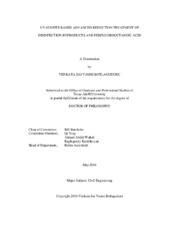| dc.contributor.advisor | Batchelor, Bill | |
| dc.creator | Botlaguduru, Venkata S | |
| dc.date.accessioned | 2016-07-08T15:18:10Z | |
| dc.date.available | 2018-05-01T05:49:35Z | |
| dc.date.created | 2016-05 | |
| dc.date.issued | 2016-05-09 | |
| dc.date.submitted | May 2016 | |
| dc.identifier.uri | https://hdl.handle.net/1969.1/157150 | |
| dc.description.abstract | Advanced reduction processes (ARP) are a class of chemical treatment processes that target oxidized contaminants in water/wastewater. ARPs operate through the generation of reducing radical species such as the hydrated/aqueous electron (eaq-). UV irradiation of sulfite (SO3^2-) in solution is an effective generation method for eaq-. The photochemistry of sulfite in solution renders the UV/ SO3^2- ARP advantageous for application to water/wastewater treatment. UV/SO3^2- ARP was successfully tested for application to disinfection byproduct removal and perfluorooctanoic acid (PFOA) defluorination.
Batch experiments were conducted to develop kinetic data for defluorination of PFOA. A pseudo component kinetic model for stepwise defluorination of PFOA was applied to experimental observations of inorganic fluoride to obtain two rate constants for PFOA defluorination. The effectiveness of UV/SO3^2- ARP was tested under UV-L and excimer lamps. Quantum yields for the process were calculated to be in the range of 0.002 to 0.004 mol/Ein. Presence of radical scavengers such as alkalinity lowered the kinetics and quantum yields for the process. Excimer lamp offered improvement in kinetics but required greater energy input, due to low UV conversion efficiency.
Photolytic removal of chlorite (ClO2^-) was investigated under UV-L lamp. Aqueous chlorite photolysis resulted in a reduced form (Cl^-) and an undesirable oxidized form (chlorate, ClO3^-). The effect of background water constituents, natural organic matter (NOM) and alkalinity, on photo degradation of chlorite was studied. Results indicate that NOM significantly reduces chlorate formation by scavenging oxidizing radicals and hindering chlorine dioxide production. The problem of chlorate formation due to high DO in water could be eliminated by applying UV/SO3^2- ARP with high sulfite doses.
Batch kinetic experiments for reduction of bromate (BrO3^-) with UV/SO3^2- ARP were conducted. A generic kinetic model for functioning of ARPs was applied to understand the effects of process variables on bromate reduction kinetics. Low wavelength excimer lamp improved BrO3- reduction kinetics significantly, but required an order of magnitude higher electrical energy as compared to the UV-L lamp. The dual effect of NOM is to scavenge reducing radicals and to filter UV irradiance and these effects were examined to determine if they would be significant limitations for application of UV/SO3^2- ARP to natural waters with high NOM concentrations. | en |
| dc.format.mimetype | application/pdf | |
| dc.language.iso | en | |
| dc.subject | Redox Reactions | en |
| dc.subject | UV | en |
| dc.subject | Disinfection Byproducts | en |
| dc.subject | Perfluorooctanoic Acid | en |
| dc.subject | Advanced Reduction Process | en |
| dc.subject | Sulfite | en |
| dc.subject | Photolysis | en |
| dc.subject | Bromate | en |
| dc.subject | Chlorite | en |
| dc.title | UV-Sulfite Based Advanced Reduction Treatment of Disinfection Byproducts and Perfluorooctanoic Acid | en |
| dc.type | Thesis | en |
| thesis.degree.department | Civil Engineering | en |
| thesis.degree.discipline | Civil Engineering | en |
| thesis.degree.grantor | Texas A & M University | en |
| thesis.degree.name | Doctor of Philosophy | en |
| thesis.degree.level | Doctoral | en |
| dc.contributor.committeeMember | Ying, Qi | |
| dc.contributor.committeeMember | Abdel-Wahab, Ahmed | |
| dc.contributor.committeeMember | Karthikeyan, Raghupathy | |
| dc.type.material | text | en |
| dc.date.updated | 2016-07-08T15:18:10Z | |
| local.embargo.terms | 2018-05-01 | |
| local.etdauthor.orcid | 0000-0001-8146-0620 | |


